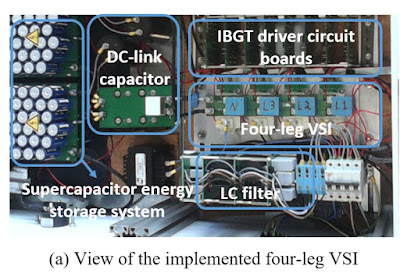sexta-feira, 14 de abril de 2017
AC-AC VOLTAGE REGULATION BY SWITCH MODE PWM CÛK VOLTAGE CONTROLLER WITH IMPROVED PERFORMANCE by Palash Kumar Banerjee - Ryerson University- Master of Engineering
AC-AC VOLTAGE REGULATION BY SWITCH MODE PWM CÛK VOLTAGE CONTROLLER WITH IMPROVED PERFORMANCE by Palash Kumar Banerjee
A project presented to Ryerson University in partial fulfillment of the requirement for the degree of Master of Engineering in the program of Electrical and Computer Engineering Toronto, Ontario, Canada, 2014
ABSTRACT
Title: AC-AC Voltage Regulation by Switch Mode PWM Cûk Voltage Controller With Improved Performance
Degree: Master of Engineering
Year: 2014
Student Name: Palash Kumar Banerjee
Program: Electrical and Computer Engineering University: Ryerson University, Canada
In this research project, an AC Cûk voltage regulator has been proposed for maintaining constant voltage across the load during wide range of input voltage fluctuations. The proposed AC Cûk voltage regulator made of practical IGBT switches has been investigated for both manual and automatic control circuit. A fraction of the output voltage is taken as the input voltage of the control circuit and produce the error signal if any changes occur in the output voltage. The modified error signal is used to make PWM signals for switching devices as per output voltage of regulator. The PWM controls the ON/OFF time (Duty cycle) of switching devices (IGBTs) of the proposed regulator. As a result the regulator is maintaining a constant voltage across the load during any change in supply voltage. The simulation waveforms and the calculated total harmonics distortion (THD) values are compared with previously studied AC Buck-Boost regulator. The observed simulated waveforms of output voltage, output current and input current and THD values have been improved in case of proposed AC Cûk voltage regulator.
LINK VIEW FULL TEXT
http://digital.library.ryerson.ca/islandora/object/RULA:2617
quarta-feira, 12 de abril de 2017
INFINEON HIGH POWER SEMINARIO TECNICO -TCT-ARTIMAR-27 ABRIL 2017 SÃO PAULO BRASIL
A TCT Brasil em parceria com a Artimar, está promovendo o primeiro seminário técnico da Infineon no Brasil sobre semicondutores de potencia. A líder mundial e seus especialistas prepararam uma agenda completa com os principais temas da atualidade, sobre módulos IGBTs e bipolares. Para credenciamento favor enviar e-mail - contato@tctbrasil.com.br
segunda-feira, 10 de abril de 2017
Output Voltage Quality Evaluation of Stand-alone Four-Leg Inverters Using Linear and Non-Linear Controllers- Instituto Superior de Engenharia de Lisboa
Output Voltage Quality Evaluation of Stand-alone Four-Leg Inverters Using Linear and Non-Linear Controllers Ricardo Luís , José Fernando Silva and José Carlos Quadrado
Instituto Superior de Engenharia de Lisboa, Polytechnic Institute of Lisbon,
Abstract:
This paper presents the design and experimental voltage quality evaluation of controllers for the output voltages of 3-phase four-leg voltage source inverters. These inverters are needed in stand-alone power systems to supply linear and non-linear, balanced or unbalanced loads with constant RMS value voltages at fixed frequency. Comparisons include closed loop outer voltage controllers based on predictive, sliding mode and decoupled proportional-integral controllers in dqo synchronous space, fitted with an inner hysteretic current loop vector controller in abg space. The 3-phase four-leg VSI output voltages waveform quality is analysed under unbalanced and non-linear loads. Received: 7 February 2017; Accepted: 29 March 2017; Published: 9 April 2017
Download PDF [5971 KB, uploaded 9 April 2017]
http://www.mdpi.com/1996-1073/10/4/504/pdf
segunda-feira, 3 de abril de 2017
A High-Efficiency Isolated-Type Three-Port Bidirectional DC/DC Converter for Photovoltaic Systems Yu-En Wu and Pin-Nan Chiu Department of Electronic Engineering, National Kaohsiung First University of Science and Technology,Taiwan
A High-Efficiency Isolated-Type Three-Port Bidirectional DC/DC Converter for Photovoltaic Systems Yu-En Wu * and Pin-Nan Chiu Department of Electronic Engineering, National Kaohsiung First University of Science and Technology, Kaohsiung 824, Taiwan
Abstract
This paper proposes a novel high-efficiency isolated three-port bidirectional DC/DC device for photovoltaic (PV) systems. The device contains a high step-up converter for PV modules to supply power to the DC bus, and a bidirectional charge/discharge control circuit for the battery with an improved boost-flyback converter. When the PV modules supply sufficient energy, their output can be stepped up and energy supply to the DC bus and charging of the battery can be achieved simultaneously. However, when the energy supplied is insufficient, the battery provides energy to the DC bus. When the proposed converter is operated in the step-down mode, the DC-blocking capacitor on the high-voltage side is used to reduce the voltage on the transformer and achieve high step-down performance. Moreover, to improve the overall efficiency of the system, the energy stored in the leakage inductance is recycled and supplied to the DC-blocking capacitor during operation in the step-up mode. Finally, to verify the feasibility and practicability of the proposed devices, a 500 W three-port bidirectional DC/DC devices was implemented. The highest efficiencies achieved for operation in different modes were as follows: high step-up mode for the PV modules, 95.2%; battery step-up mode, 94.2%; and step-down mode, 97.6%. View Full-Text Keywords: isolated type; three-port bidirectional converter; photovoltaic systems.
LINK ORIGINAL
http://www.mdpi.com/1996-1073/10/4/434
Assinar:
Postagens (Atom)












































 JOSIL ARTISTA PLASTICO FORTALEZA CEARA BRASIL AV.HERACLITO GRAÇA 41 TEL(85)32542378
JOSIL ARTISTA PLASTICO FORTALEZA CEARA BRASIL AV.HERACLITO GRAÇA 41 TEL(85)32542378
















